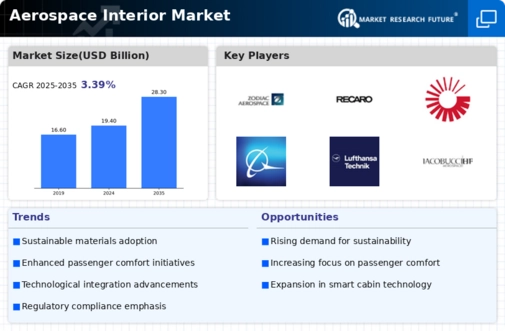Market Growth Projections
The Global Aerospace Interior Market Industry is poised for substantial growth, with projections indicating a market size of 19.4 USD Billion in 2024 and an anticipated increase to 28.3 USD Billion by 2035. This growth trajectory suggests a robust demand for innovative and comfortable aircraft interiors, driven by factors such as technological advancements, regulatory compliance, and an increase in air travel. The market is expected to grow at a CAGR of 3.5% from 2025 to 2035, reflecting the ongoing evolution of the aerospace industry and the continuous investment in enhancing passenger experiences.
Sustainability Initiatives in Aviation
Sustainability initiatives are becoming a cornerstone of the Global Aerospace Interior Market Industry. Airlines and manufacturers are increasingly focusing on eco-friendly materials and designs to reduce their environmental footprint. This shift towards sustainability not only aligns with global environmental goals but also appeals to environmentally conscious consumers. The adoption of recyclable materials and energy-efficient manufacturing processes is on the rise. As a result, the market is likely to see a transformation in product offerings, with a growing emphasis on sustainable practices that meet both regulatory requirements and consumer expectations.
Growing Demand for Lightweight Materials
The Global Aerospace Interior Market Industry experiences a notable shift towards lightweight materials, driven by the need for fuel efficiency and reduced operational costs. Manufacturers increasingly adopt advanced composites and aluminum alloys, which not only enhance structural integrity but also contribute to weight reduction. This trend aligns with the industry's goal to lower emissions and improve overall performance. As a result, the market is projected to reach 19.4 USD Billion in 2024, reflecting a growing preference for innovative materials that meet stringent regulatory standards while ensuring passenger comfort and safety.
Increase in Air Travel and Fleet Expansion
The Global Aerospace Interior Market Industry is experiencing growth due to the increase in air travel and fleet expansion. As global economies recover and consumer confidence rises, airlines are expanding their fleets to accommodate the growing number of passengers. This expansion necessitates the modernization of aircraft interiors to enhance passenger comfort and satisfaction. The market is projected to grow at a CAGR of 3.5% from 2025 to 2035, reflecting the increasing demand for upgraded interiors that meet the expectations of modern travelers. Airlines are investing in new aircraft with advanced interiors to remain competitive in this evolving landscape.
Regulatory Compliance and Safety Standards
The Global Aerospace Interior Market Industry is heavily influenced by stringent regulatory compliance and safety standards. Governments and aviation authorities impose regulations that dictate the materials and designs used in aircraft interiors to ensure passenger safety and comfort. Compliance with these regulations often necessitates significant investment in research and development, pushing manufacturers to innovate continually. This focus on safety not only enhances the reputation of airlines but also drives market growth. As the industry evolves, adherence to these standards is likely to remain a critical driver, influencing design choices and material selection.
Technological Advancements in Cabin Design
Technological advancements play a pivotal role in shaping the Global Aerospace Interior Market Industry. Innovations in cabin design, including the integration of smart technologies, enhance passenger experience and operational efficiency. Features such as mood lighting, advanced entertainment systems, and improved seating ergonomics are becoming standard. These enhancements not only attract passengers but also optimize space utilization. As airlines invest in modernizing their fleets, the market is expected to grow significantly, with projections indicating a rise to 28.3 USD Billion by 2035, driven by the demand for more sophisticated and comfortable travel experiences.










